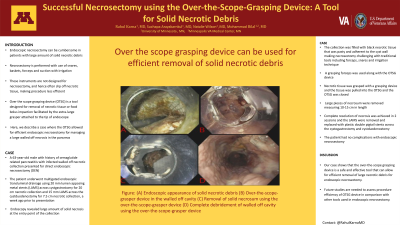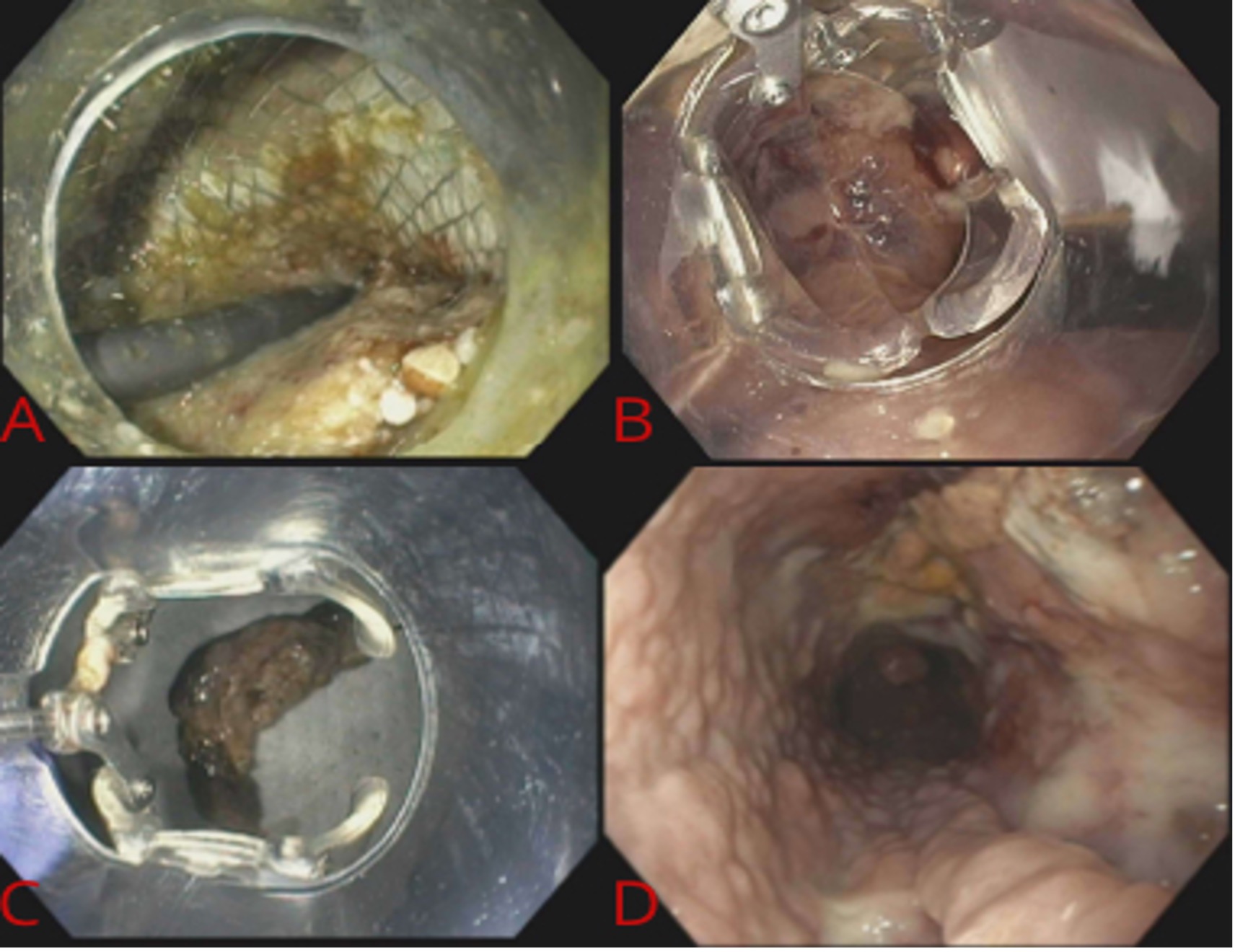Monday Poster Session
Category: Interventional Endoscopy
P2799 - Successful Necrosectomy Using the Over-the-Scope-Grasper Device: A Tool for Solid Necrotic Debris
Monday, October 28, 2024
10:30 AM - 4:00 PM ET
Location: Exhibit Hall E

Has Audio
- RK
Rahul Karna, MD
University of Minnesota Medical Center
Minneapolis, MN
Presenting Author(s)
Rahul Karna, MD1, Suchapa Arayakarnkul, MD2, Natalie Wilson, MD2, Mohammad Bilal, MD3
1University of Minnesota Medical Center, Minneapolis, MN; 2University of Minnesota, Minneapolis, MN; 3University of Minnesota and Minneapolis VA Health Care System, Minneapolis, MN
Introduction: Endoscopic necrosectomy can be cumbersome in patients with large amount of solid necrotic debris. Traditionally, necrosectomy has been performed with the use of snares, baskets, forceps and suction with intermittent irrigation. These instruments are not designed for necrosectomy, and hence, they often slip off necrotic tissue, making the procedure less efficient. Over the scope grasper device (OTSG) is a tool designed for removal of necrotic tissue or food bolus impaction facilitated by the extra-large grasper attached to the tip of endoscope. Here, we describe a case where the OTSG allowed for efficient endoscopic necrosectomy for managing a large walled off necrosis in the pancreas.
Case Description/Methods: A 63-year-old male with history of semaglutide related pancreatitis with infected walled off necrotic collection presented for direct endoscopic necrosectomy (DEN). The patient underwent multigated endoscopic transluminal drainage using 20 mm lumen apposing metal stents (LAMS) across cystgastrostomy for 20 cm necrotic collection and 15 mm LAMS across the cystoduodenostomy for 7.5 cm necrotic collection, a week ago prior to presentation. Endoscopy revealed large amount of solid necrosis at the entry point of the collection. The collection was filled with black necrotic tissue that was pasty and adherent to the cyst wall making necrosectomy challenging with traditional tools including forceps, snares and irrigation technique. OTSG was used to perform necrosectomy. A grasping forceps was used along with the OTSG device. The necrotic tissue was grasped with a grasping device and the tissue was pulled into the OTSG and the OTSG was closed. Large pieces of necrosum were removed measuring 10-15 cm in length. Complete resolution of necrosis was achieved in 2 sessions and the LAMS were removed and replaced with plastic double pigtail stents across the cystogastrostomy and cystoduodenostomy. The patient had no complications with endoscopic necrosectomy.
Discussion: Our case shows that the over-the-scope grasper device is a safe and effective tool that can allow for efficient removal of large necrotic debris for endoscopic necrosectomy. Future studies are needed to assess procedure efficiency of OTSG device in comparison with other tools used in endoscopic necrosectomy.

Disclosures:
Rahul Karna, MD1, Suchapa Arayakarnkul, MD2, Natalie Wilson, MD2, Mohammad Bilal, MD3. P2799 - Successful Necrosectomy Using the Over-the-Scope-Grasper Device: A Tool for Solid Necrotic Debris, ACG 2024 Annual Scientific Meeting Abstracts. Philadelphia, PA: American College of Gastroenterology.
1University of Minnesota Medical Center, Minneapolis, MN; 2University of Minnesota, Minneapolis, MN; 3University of Minnesota and Minneapolis VA Health Care System, Minneapolis, MN
Introduction: Endoscopic necrosectomy can be cumbersome in patients with large amount of solid necrotic debris. Traditionally, necrosectomy has been performed with the use of snares, baskets, forceps and suction with intermittent irrigation. These instruments are not designed for necrosectomy, and hence, they often slip off necrotic tissue, making the procedure less efficient. Over the scope grasper device (OTSG) is a tool designed for removal of necrotic tissue or food bolus impaction facilitated by the extra-large grasper attached to the tip of endoscope. Here, we describe a case where the OTSG allowed for efficient endoscopic necrosectomy for managing a large walled off necrosis in the pancreas.
Case Description/Methods: A 63-year-old male with history of semaglutide related pancreatitis with infected walled off necrotic collection presented for direct endoscopic necrosectomy (DEN). The patient underwent multigated endoscopic transluminal drainage using 20 mm lumen apposing metal stents (LAMS) across cystgastrostomy for 20 cm necrotic collection and 15 mm LAMS across the cystoduodenostomy for 7.5 cm necrotic collection, a week ago prior to presentation. Endoscopy revealed large amount of solid necrosis at the entry point of the collection. The collection was filled with black necrotic tissue that was pasty and adherent to the cyst wall making necrosectomy challenging with traditional tools including forceps, snares and irrigation technique. OTSG was used to perform necrosectomy. A grasping forceps was used along with the OTSG device. The necrotic tissue was grasped with a grasping device and the tissue was pulled into the OTSG and the OTSG was closed. Large pieces of necrosum were removed measuring 10-15 cm in length. Complete resolution of necrosis was achieved in 2 sessions and the LAMS were removed and replaced with plastic double pigtail stents across the cystogastrostomy and cystoduodenostomy. The patient had no complications with endoscopic necrosectomy.
Discussion: Our case shows that the over-the-scope grasper device is a safe and effective tool that can allow for efficient removal of large necrotic debris for endoscopic necrosectomy. Future studies are needed to assess procedure efficiency of OTSG device in comparison with other tools used in endoscopic necrosectomy.

Figure: (A) Endoscopic appearance of solid necrotic debris (B) Over-the-scope-grasper device in the walled off cavity (C) Removal of solid necrosum using the over-the-scope-grasper device (D) Complete debridement of walled off cavity using the over-the-scope-grasper device
Disclosures:
Rahul Karna indicated no relevant financial relationships.
Suchapa Arayakarnkul indicated no relevant financial relationships.
Natalie Wilson indicated no relevant financial relationships.
Mohammad Bilal: Boston Scientific – Consultant. Cook endoscopy – Speakers Bureau.
Rahul Karna, MD1, Suchapa Arayakarnkul, MD2, Natalie Wilson, MD2, Mohammad Bilal, MD3. P2799 - Successful Necrosectomy Using the Over-the-Scope-Grasper Device: A Tool for Solid Necrotic Debris, ACG 2024 Annual Scientific Meeting Abstracts. Philadelphia, PA: American College of Gastroenterology.
